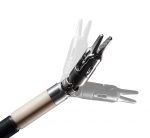With the global rise of technological advances, robots have transformed from an idea of the future to a present reality. They are entering every industry, from military and agriculture to consumer products. More recently, medtech companies have been seeking to develop robots in the healthcare industry. Although Western countries currently have the largest market for medical robots, Asian governments and companies have begun investing in their own development of medtech robots as well.
Robotic Surgery
Robotic surgery most often refers to minimally invasive surgeries in which surgeons use robotic arms to operate on patients. Benefits to robotic surgery include greater accuracy and precision, less variation between surgeons, increased safety, fewer complications, improved patient outcomes, and shorter recovery periods. However, the greatest disadvantage to robotic surgery is the cost, which is often more expensive than regular surgery.
Intuitive Surgical Inc.’s da Vinci Surgical System is a leading robotic technology in the global market today. Approved by the FDA in 2000, it can be used in cardiac, thoracic, colorectal, general, head and neck, gynecology and urology surgeries. The da Vinci system operates by making small incisions, using its robotic arms that imitate human wrists. Surgeons operate remotely with enhanced 3-D, HD visualization and imaging. Hospitals all around the world have imported the da Vinci system and have conducted thousands of successful surgeries using it.
It took several years for Tianjin University, based in China, to develop a minimally invasive surgical robot system called the Micro Hand S. From 2014 to 2015, the system went through human clinical trials, operating on patients in need of laparoscopic surgery. With positive results and no technical problems or complications encountered, the Micro Hand S has the potential to be a safe and effective system for surgeries in the future. Surgeons in China are required to go through extensive training before they are able to use the surgical robot in operations.
Hong Kong is a leading location in Asia where many robotic surgeries have been performed. In 2012, Hong Kong acquired the first Robotic Interactive Orthopedic (RIO) system in Asia from MAKO Surgical Corporation (acquired by Stryker Corp.). The RIO system is mainly used for partial knee replacement surgeries, but can potentially be used for hip, ligament, and spinal surgeries as well. The RIO system enables the surgeon to hold and guide the robotic arm during the surgery, rather than operate it remotely on a console. Not only can surgeons perform more difficult surgeries with the RIO system, but they can also sometimes do it with less experience.
The University of Hong Kong is developing the first robot for abdominal surgeries that is inserted into natural orifices using a tube, and it is assembled inside the patient’s body instead of cutting into the body. Animal testing with this robot have been successful, but it is not yet ready for human clinical trials.
Taiwan has the most surgical robots in Asia relative to its population. While there are benefits to robotic surgery as discussed earlier, many hospitals in Taiwan are being criticized for recommending expensive robot-assisted surgeries when traditional surgeries would have sufficed.
In Japan, the government is currently collaborating with five universities and 14 companies to develop a robotic surgery system that allows doctors to operate with more precision and accuracy, as well as simultaneously monitor MRI readings and data from other devices. In 2015, Japanese researchers revealed EMARO, an air-powered endoscopic robot that gives surgeons hands-free control and enhances visualization inside a patient’s body with three movable cameras. It is expected to be marketed to hospitals and universities in Japan in the fall of 2016 and be available overseas within the next few years.
Like many other Asian countries, Korea is adapting surgical robots for healthcare, too. Robotic surgery training is not required in Korea and has sometimes led to adverse events that possibly could have been avoided. A training center was therefore opened in 2008 at a Korean hospital for surgeons to gain experience and practice the skills necessary to operate surgical robots. Inspired by the renowned da Vinci system, the Meere Company in Korea has been developing the new Revo-i system since 2007. Revo-i is a robot for laparoscopic surgeries that will be used to treat cancer. It is undergoing human testing this year and is estimated to cost a third of the price of the da Vinci system.
Researchers at Koh Young Technology in Korea are also developing a neurosurgical robot for microscopic procedures on the brain and spinal cord. In 2007, Curexo, Inc. assisted in developing Robodoc, an orthopedic surgical robot. The Hyundai Group invested in Robodoc and has been developing medical robots as well, including one called the “Morning Walk” that aids patients in rehabilitation and walking.
Unlike the integration and development of robotic surgery in China, Japan and Korea, robotic surgery in India is just beginning. Several surgical robots were only recently purchased for government hospitals. Advanced technology and training are not yet readily accessible in India. However, healthcare technology companies and government hospitals are collaborating and planning on providing robotic surgery training to at least 500 Indian surgeons by 2020.
Other Types of Medtech Robots
Researchers are also looking to adapt robotic technology used in other industries for healthcare needs. For example, automated guided vehicles used to carry heavy items in warehouses can be used to carry objects or transport people in hospitals. Panasonic’s autonomous delivery robot, HOSPI, is able to assist delivery operations by transporting medicine, patient files and medical specimens throughout hospitals. It was previously only implemented in Japan and is now undergoing experimentation in a Singapore hospital.
Abacus Global Technology, a Singapore-based robotic company, is developing diagnostic robots such as the AmaKris SR 2, which can diagnose colon cancer as well as perform colonoscopies. This would reduce costs, allow less-experienced doctors to perform colonoscopies, and facilitate advanced telemedicine. Abacus also developed service robots that make transporting patients and laboratory samples easier, along with sensors that recognize when patients get out of or fall from the bed.
Companies around the world are racing to transform healthcare through robotic assistance, from delivering drugs to doctors in hospitals to entertaining children who are about to receive a shot. Other current developments include:
- Robotic exoskeleton suit that assists muscle mobility for disabled patients and potentially regenerates damaged nerves
- Robot with a teddy bear face that lifts, bathes and monitors seniors and patients
- Interactive robots that increase the quality of life and care for seniors who want to live independently in rural areas
- Fitness robot that encourages rehabilitation and guides patients and seniors in exercise routines
Technological advances in robotics are rapidly increasing across the globe. Healthcare robots can enhance the accuracy of surgeries, lessen the burden on nurses and doctors, and aid in the treatment of senior citizens. In general, robotic healthcare products have received a positive response from doctors in Asia, and local Asian companies are quickly developing these products on their own.







